Hello and welcome to Interviews From Behind The Universe!
by Nicholas Brown
Today we have the illustrious comic historian Rick Marschall to give us a glimpse into his career in the Marvel bullpen and wild wild world of publishing.
He was editor at Marvel Comics back in the 70s before he broke into the publishing world with a multitude of his own books, magazines and illustrations. You may well have seen his name fly by your local bookstore without even noticing! Unless you are a dedicated reader of this lovely blog because he has been all over this thing.
Eliot and I were once wandering the book section at our local Ollie’s Bargain Outlet (not a sponsored post!) when he suddenly snatched up a copy of Bully!: The Life and Times of Theodore Roosevelt, which dissected the era’s political cartoons, their impact and meaning written by Mister Rick Marschall. Of course, Dad had told me about him before, but I had never appreciated his clear passion for the medium until seeing it laid out like that.
As so many of these things go, it started with a childhood love of comics but not quite how you might be expecting. I can let Rick take over from here.
Q: What got you to get into the Marvel Comics job in the first place?
I had been in comics most of my “career,” as a political cartoonist; Comics Editor for three newspaper syndicates; historian; and collector. I already was active in these areas, and was about 28 years old, when I wrote to Stan Lee about working at Marvel.
I had never really been a fan of superhero comics growing up — my cousin Tommy was, and he gave me all his DC and Marvel cast-offs — however I was a huge fan of the Disney comics, Little Lulu, Archie, the rest. Of the 10-cent funnybooks, I mean; the older comics, newspaper reprints, I loved. I remember on Summer vacation one year I was supremely hesitant about buying a Harvey reprint of the Phantom by Wilson McCoy — should I break my record of not buying something NOT a humor or funny animal book? This, despite that most of McCoy’s jungle creatures were funny-looking animals. My friend convinced me that this was a foolish consistency of mine.
So, fast-forward to when I was disillusioned with newspaper strips after three editorial jobs — humor strips in doldrums; story strips weaker by the month; papers shrinking and cutting. So I contacted Stan, whom I knew while at Publishers Syndicate in Chicago. It sounds unlikely, the project we had discussed; but we all know that Stan was a whirling dervish of entrepreneurial ideas and random project always a-borning, his whole life.
We had discussed partnering on a magazine that would have been like the European magazines Linus or Eureka — a mix of recent reprints (strips and comic books), news, interviews, reviews, showcased art. Johnny Hart (BC and Wizard of Id comics trips) was going to be the backer, with the syndicate; I would have been Editor; Marvel would have published.
Obviously, it never happened (after I was at Marvel, Stan was cleaning house one day and gave me his copy of the “dummy” we had put together) — but that’s how I knew Stan, and felt comfortable in approaching him. I also knew European comics and had dreams that graphic novels — before they even took that name — could make it in America. That much I shared in my outreach to Stan; what I kept to myself, at the time, was my horror that comic-book artists did not have creators’ rights as was standard in Europe. I pressed that when I was hired, and was assigned the launch of what turned out to be EPIC Magazine.
But I’m getting ahead of myself. After the letter to Stan, I was hired, and I started the same day as Mark Gruenwald and Bob Hall. I have read that Jim Shooter has spun some stories about his hiring of me, but they are nonsense; it was through Stan. In fact, during my first week I wrote some office memo to Jim and misspelled his name as Shuter; I had never heard of him till then. At first I was in charge in the magazine line; the black-and-white titles; color Super Specials, movie adaptations; etc.
I’m going beyond your specific question, but one reinforcement of my memory, and a humorous aside, is that Shooter later said that after a few weeks he assigned Ralph Macchio to be my assistant partly with the idea that this new guy, me, from the corporate world, would keep Ralph in line. Well, I guess my jackets and ties fooled him, but I am the biggest class clown and practical joker I know… so Ralph and I were a natural fit.
Some time Eliot should do a column on ONLY the practical jokes at Marvel. We got work done, certainly; but otherwise, in between, it was like a frat party.
The old upside-down glasses gag! Never fails to evoke uncomfortable laughter. Rick Marschall (L) with Mark Gruenwald (R).
Q: Do you have any stories from the Bullpen that you’d like to tell? Perhaps something Eliot has overlooked in his writings or that you’d like to add to.
Gee, I don’t know. Ralph and I were given an office that was kind self-contained, at the intersection of hallways, and a big glass wall that faced the office Xerox machine. We could see everyone face-on as they photocopied things. As a former political cartoonist I had a little talent, or at least experience, at caricature. So before too long I managed to do… um… portraits of most the staff and freelancers. I suppose it was a little suicidal, because, well, I wasn’t a portrait painter, right? I always chucked them after getting laughs out of Ralph and Marie Severin (she had a wicked humor few saw!) but Ralph retrieved them and tacked to the corkboard-wall next to his desk. Eventually there was a rogue’s gallery of everyone in the (human) Marvel universe.
Marie was a good friend I only met when I joined Marvel but I had known her brother John since childhood. Mine, not his. He lived a town away from me, and rented a studio in another adjacent town (Harrington Park, NJ). I used to ride my bicycle and spend afternoons with him. He had pink curtains (it was a storefont he rented) because he didn’t want to be bothered, but he always insisted I return – he give me drawing lessons and tips; and showed me things that floated his boat from books on his shelves (I remember the rare Heinrich Kley anthologies) and eventually I brought along show-and-tell stuff I founded for the collection.
It might seem natural, but it was uncanny how alike John and Marie were… speech, mannerism, laughs.
Back to the Bullpen. No “inside baseball” about characters or plotlines, but about Ralph and me and our office’s unique location. Once there had been a trade show (before comic-book publishers even went to San Diego – I have told here the story of how I was responsible for the first time, right?) but one day, out by the elevators, there was a sign, like a theater marquee, about eight or 10 feet long, with lights around its periphery, and a bold, sparkling “Marvel Comics.” It was meant to be thrown away. Ralph and I rescued it, affixed it our wall, and the thing stayed for a while. It was so bright we didn’t need the office’s ceiling lights; and I don’t know, I might have even gotten sun-burn because of the darn thing.
The most glamorous comic office in history! Ralph (L) and Rick (R) with gigantic light chaser sign! 1979 at Marvel’s offices at 575 Madison Avenue!
[The story of Marschall and Brown at Marvel’s first Comic Con can be found right over here! Strap in, it’s a multi part entry -Editor]
Besides my poison caricatures, I had a little talent for impersonations. Ralph was even better impersonating people. So our vantage point enabled us, with our door closed of course, to invent imaginary dialogs and conversations of the people we saw on the other side of the glass. It was a riot.
Then it was only a step away from one of the classic practical jokes of the ages. I ought to feel guilty, and maybe some day I will. After Ralph does. Anyway, we each were pretty good “doing” the voices of a couple freelancers, especially. Since we could see who was in the Marvel offices that day, and not back in their apartment, – and I am NOT going to name the artists! — we called the home phone of one, and left a message in “the voice” of another. Then, vice versa. Whatever we said makes no differences, except that we noticed that when they were in the bullpen on some random day, they started to get angry with “You did…” “I didn’t…” “Why did you call?…” until it escalated to “Stop effing with me!” and “Leave me the eff alone!” and such pleasantries. When we realized this growing feud could be scripted and have the latest rants referred to – all in those golden days before cell phones and caller ID – it was great sport. One of the most colorful feuds in Marvel history, and they never knew Who, What, When, Where, or How. (I think we always let Jim Salicrup in on these schemes. He was a great audience.)
Oh, yeah, this is an art form.
[More of Rick and Ralph’s misadventures, including pics of the lovely Marvel sign have been covered by Eliot in his entry here -Editor]
Q: So one thing that comes up a lot around you is your collection of classic newspaper strips and comics, how did that come about? And what have you done with it over the years?
That’s how I got interested in comics… or, I don’t know; which is the cart and which is the horse? When I was a kid my father had the few books extant on comic-strip history. I devoured them, and was attracted by the older material. Happy Hooligan, Katzenjammer Kids. My dad was never an artist but was a huge fan. He read only the New York Times on Sunday (I grew up in Closter, NJ) but between subscriptions, out-of-town newsstands in Manhattan, and friends and relatives around the country, we got 14 Sunday funnies. Some strips overlapped, of course, but I was aware of every strip being drawn, just about; and I saved them all. And my dad clipped the daily strips each night from the local paper for me. Even when I was away at college.
That started me. Al Smith, who drew Mutt and Jeff, lived nearby and went to our church for awhile. I was very young when my pastor brought me to meet him, and Al critiqued my drawings. Before we left, he brought three originals from his studio and gave them to me: two of his; and one magnificent 1927 Mutt and Jeff daily signed Bud Fisher. Huge. Full of crosshatching, detail, slapstick, and enough dialog to fill a Reader’s Digest.
Like Ralphie in Jean Shepherd’s Christmas Story, at Santa’s feet – “Football? What’s a football???” – I never had even though about original art. I suppose I thought they were drawn the size they were printed in newspapers.
I saw those drawings, and my future life passed before my eyes.
Al introduced me to other cartoonists in the area, then so on and so forth – the woods in the New York suburbs were full of cartoonists – until I met, and really was friendly with, cartoonists like Vern Greene, Paul Norris, Otto Messmer. When Al took me to a meeting of the National Cartoonists Society when I was 11 or 12, then I met and was befriended by Rube Goldberg, Harry Hershfield, Charlie Payne, Russell Patterson; a lot of legends as well as contemporary cartoonists. On school vacations I visited newspaper syndicates in Manhattan, with my drawings. I never had realistic dreams of selling a feature, but the syndicates very free with originals in those days.
Rick soothing a sleepy daughter, Heather! With experience gained from so many sleepy readers of his work.
My dad visited the dozens of used-book stores in lower Manhattan almost every weekend, and would take me along; that’s how my book collecting began; and of course the largesse of cartoonists. He helped me write fan letters to cartoonists, and I received signed originals from Charles Schulz, Walt Kelly, Mort Walker, even Crockett Johnson. Every year. On vacation to Florida, my dad set apart two days for visits (arranged in advance) with the community of cartoonists there; so I counted Frank King, Les Turner, Lank Leonard, and Fred Lasswell among new friends. We always had good visits, but I realize I must have been something of a freak, this young teen (or whatever) who knew, and researched, and asked about the Old Masters of cartooning. Harry Hershfield used to say that every time I visited I would remind him of someone he had not thought about for 40 years.
And so it grew. I drew and wanted to be a political cartoonist. In college I drew for local papers in the DC area; and some national magazines. Never for my college paper because the Cancel Culture was already in effect. I drew for a New England chain of papers after graduation… and lived among the greatest cartooning colony, in Fairfield County, CT. Many of the guys became friends and even attended my wedding – Dik Browne, Gill Fox, Mort Walker, Stan Drake, Lenny Starr, Jerry Dumas, Dick Hodgins.
Then I got a job with United Feature Syndicate as Comics Editor and kind of slid out of political cartooning – although I still freelance – and was Comics Editor for the News-Tribune Syndicate and Publishers Syndicate in Chicago. Then, as I have said, Marvel. Then I wrote for Disney Comics in Europe, then (thanks to Len Starr and Stan Drake) was the American rep for Dargaud, the French publisher.
Before and after all that I pursued my other interests. I have written 74 books – many on comics; and anthologies; but also in the fields of history, biography, country music, television history and criticism, Baroque music, children’s books, Christian apologetics, and so forth. A lot of magazine articles, and I have taught at four colleges, consulted on the Century of Comics series of stamps for the Post Office, and traveled to Europe 60 times, often for comics festivals. I have launched five magazines (including NEMO and Hogan’s Alley, on comics) and edited eight; NEMO is about to be re-launched. A huge interest is Theodore Roosevelt (two books) and I currently serve as the Cartoon Archivist for the Theodore Roosevelt Center at Dickinson State University.
Finally – since this was part of your question, long ago; sorry – I have collected a rather massive archive (a full house and eight storage facilities) of artwork; vintage magazines and newspaper comic sections; books; cartoon memorabilia.
Rick interviewing the Bros. Hildebrandt for Epic Magazine!
Q: Have you enjoyed seeing where Marvel has taken its characters in recent years? I’m referring mostly to the Marvel Cinematic Universe and its extended factions, but if you’ve kept up with Marvel Comics as well, I’m curious to hear your take.
I do not really keep up with the current material. The books I see, and the movie spin-offs, frankly are too violent and sexy and brutal for my tastes… and would have been back in “my day.” I don’t think I contributed to any of that evolution. When I started EPIC, I often pitched it to creators on several levels: Creators’ rights, which I would fight for; Quality production values, and therefore a challenge to produce “camera-ready” painted artwork; mature material… but (specifically) not on the soft-core level of Heavy Metal.
Those were always standards, even on other projects I subsequently worked on; but the world has passed me by. I am just answering your question about whether I have ”enjoyed” recent turns. No, not really.
Q: What was the most fun you had working on a project at Marvel?
I should say EPIC ILLUSTRATED but frankly and fully it was the three-issue Weirdworld epic, Warriors of the Shadow Realm. Three full issues, a long story that “breathed”; great production values; establishing a vision, adding some frills (gatefold 3-page panoramas). I even went to the printer in Buffalo to oversee the production. I put together a production team – John Buscema, Rudy Nebres, and Peter Ledger from Australia, who came over for the project – the Fastest Airbrush In the West.
Peter Ledger almost catching up on some late Weirdworld work on the convention floor of the 1979 San Diego Comic Convention. (L-R) arms folded Ralph Macchio, muscle shirt Peter Ledger, only tie at the con Rick Marschall.
I am very proud of Weirdworld, but I am also haunted by a regret. I oversaw the team and loved the creative integration – Buscema pencilled; Nebres colored major figures and foregrounds in black; Buscema would return and/or Ledger would watercolor broad areas and backgrounds; Nebres would ink certain elements in colored inks; finally Ledger added painterly touches, and use the airbrush to great effect.
My regret? This was an exciting process, and I felt I added a special touch by these architectonics. But I was full of myself. Maybe readers never knew it, and John Buscema never voiced this – damn, he was a gentleman – but he would have loved to do EVERY element, every inch of those pages. He loved Howard Pyle, A. B. Frost, Brangwyn, Russell Flint, Roy Krenkel, Alex Raymond, Hal Foster – great illustrators (oh! He loved Foster’s Merlin). As I say, I am proud of those books, today… but I wish I had given John Buscema full rein, start to finish.
Q: Eliot told me that you pulled off an impressive writing career, getting numerous books published during and after Marvel comics, what was that like? And was your time at Marvel helpful to this?
No, my experiences at Marvel were not “helpful” except for what I learned about the craft – editing; assembling teams; production modes. “Marvel” on my resume opened a few doors of curious people! Connections — great friendships with people like John Buscema, whom I invited to Italian comics festivals, that became a part of his life afterward; Marie Severin; Ralph; Tom Palmer; Bob Larkin; Jim Salicrup; George Roussos. Kathy Nuzzolese-Beekman, from the circulation department, but I only got to know her after we both escaped. I was proud to give some of their first work to Kubert students, Bill Sienkiewicz, and others. After Marvel, I produced some “industrial comics,” public-service things; Bill worked on one. When I moved from a house in Westport, to Weston, CT, Bill and his wife moved in downstairs; Terry Austin moved in upstairs. And. of course, Eliot Brown. Did I mention Eliot Brown? A close friend, I am a huge fan. He joined me when my little company had a booth at the Frankfurt Book Fair in Germany, and we tooled around central Europe together – Rick and El’s Excellent Adventure.
Rick in his booth at the 1989 Frankfurt Book Fair!
Q: How has life in general treated you after Marvel’s adventures?
I am blessed. I am busy – NEMO is starting up again, via Fantagraphics Books. I am busy with the digital annotation of Roosevelt cartoons, at the moment on materials from the Library of Congress. My wife Nancy had many health problems, most seriously a heart and kidney transplant; and she died eight years ago. But she was brave, an inspiration, and we started a family ministry out of her experience. I have three children: Heather is in children’s ministry; Ted is a TV news producer, right now in Washington DC; and Emily lives in Ireland, started up a thriving business in American-style BBQ. Four great grandchildren (NOT great-grandchildren, please!).
So, life in general – and God specifically – is treating me great.
Q: Do you have any embarrassing stories about my father? Anything I can use against him really.
Ha! You are out to get me in trouble… or to get him! You know what, if I had any embarrassing stories, I would at least try to slip them in here. But he’s a solid citizen, great values, and a polymath: knows something about everything. Things to admire. If you ever see his son, tell him he’s lucky to have a dad like Eliot.
Marschall’s last day Farewell Dinner. The entire 6th Floor of Editorial and Production with several execs from 9 (all from 575 Madison offices) plus many freelancers attended! (L-R)Nora Maclin, Nancy Marschall, Heather Marschall, Mr. Rick, Davida Lichter-Dale, Lynn Graem, Denny O’Neil.
Q: Where can our readers find you on social media to keep up with you?
Where in social media? Well I’m on Facebook, but want to leave… or in a race to be jailed, or banned, or “cancelled.” Things are crazy these days. I love hearing from old friends, and fielding questions from strangers. I also can be reached through my weekly Christian blog (12 years old now) Rick@MondayMinistry.com.
Thank you for your intelligent questions. I blabbed too long. But, what the heck, they are only electrons.
Well, shucks. Old reliable “any embarrassing stories about my father?” usually gets me something fun but still that is very kind of you to say!
You have been an excellent sport about this, thank you for the delightfully winding answers, this is comic history we are looking for right here.
You are right, I am going to have to convince Dad to do a piece on all the practical jokes you guys had from Marvel, once we do some research into the statute of limitations.
With out focus on the knock down beat ‘em ups at Marvel, it’s easy to forget how long the comic medium has been around. I still remember reading my dad’s copy of Little Nemo in Slumberland (A later edition edited by Marschall himself) as a kid and being entranced by the surreal adventures, we really don’t get enough of that anymore and I’m glad we have people like Rick here keeping that history alive.
Be seeing you,
-Nicholas Brown.
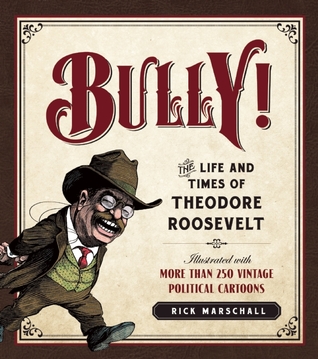
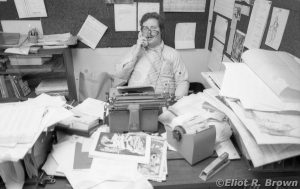
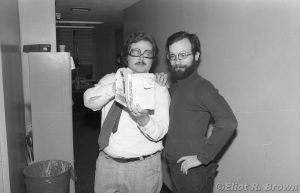
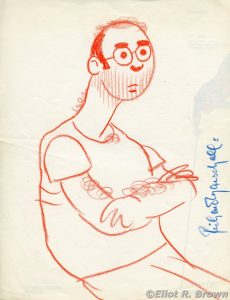
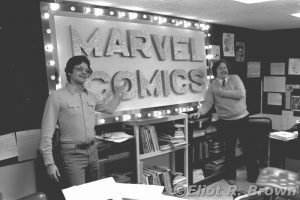
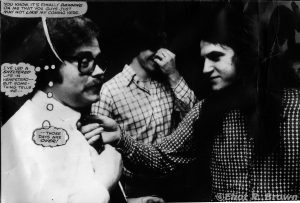
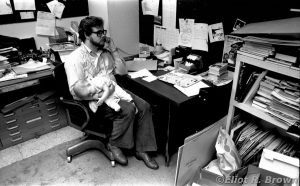
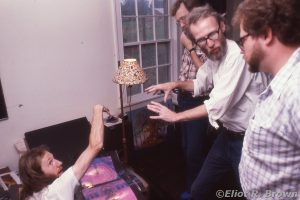
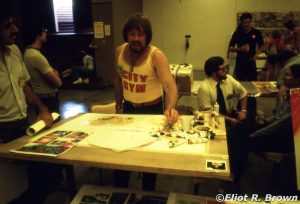
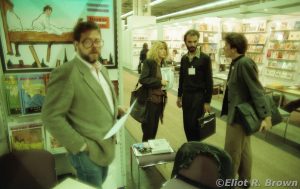
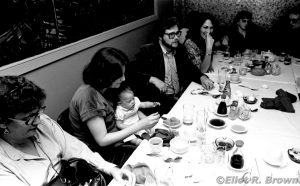
Great interview Nik. You captured a time when you could actually meet talented people just by visiting their studio down the street. Strike up a friendship. Then get invited to places to meet others of your ilk. Can you imagine any of that happening these days? Not hardly. Oh and yes, I’d absolutely be asking ANYONE that I interviewed about embarrassing Eliot Brown stories. There has to be some long forgotten trunk full of such stories in some dingy back alley book store run by a surly one eyed comic book ‘enthusiast’ just waiting to be found. KEEP SEARCHING!
Wonderful interview and greatly informative. I worked with Rich but knew relatively nothing about him.
Thanks
Mr. Rick was even more complex than this interview hints at. Best example was that he “hid” behind a suit, tie and — most of the time, and this in the mid-70s when wearing a 4-gallon hat in Manhattan was done by TV characters — a cowboy hat! When asked, ‘why’ about the hat, he replied, “Hats are silly.”
I applaud you on not only your artistic ability, but for all you have accomplished. Just love this article. Your writing shows how you love what you do. Congratulations for all your achievements.
You are very nice to say that! And I thank you. I hope to show that there’s an awful lot of talented people at every stage of comic making!
Wonderful stories! I especially like how Rick’s father cut out the daily strips and saved them for him. Sometimes it’s the little things that stay with us and change the world. Great photos of humans having fun behind the scenes at Marvel. Thank you for the introduction to Heinrich Kley!